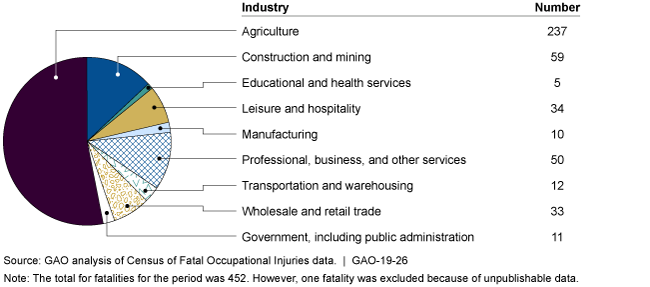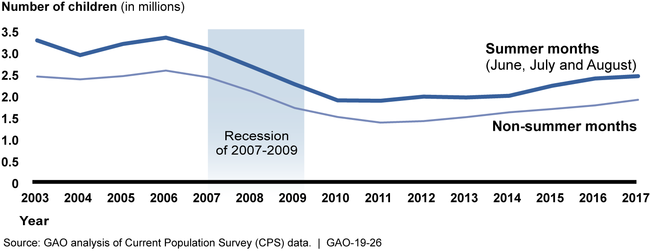Working Children: Federal Injury Data and Compliance Strategies Could Be Strengthened
Fast Facts
Many children aged 17 and under work to develop independence or meet financial needs. However, working can sometimes interfere with education, or in some industries, be physically dangerous.
We found that the majority of work-related fatalities occur among children working in agriculture—but data on children's work-related injuries in general is incomplete.
The Department of Labor is conducting a study to enhance its work-related injury data, but the study doesn't include children. We recommended including them to improve the data—which could also improve enforcement of child labor standards.
Work-Related Child Fatalities, by Industry, 2003 to 2016

Pie chart showing that 52% of work-related child fatalities occurred in agriculture.
Highlights
What GAO Found
The number of working children has fluctuated with the economy since 2003. An estimated 3.3 million children aged 15 to 17 worked in the summer months of 2003, and the number of working children reached a low of 1.9 million by 2011. It then increased to 2.5 million by 2017, but has not returned to its pre-recession level, as shown below. GAO's analysis of the U.S. Department of Commerce and the Department of Labor's (DOL) Current Population Survey data found that non-agricultural industries employed an estimated 2.5 million working children aged 15 to 17 in the summer months of 2017. Further, GAO found that the leisure and hospitality industry employed the largest number of children.
Estimated Number of Working Children Aged 15 to 17 in the United States, 2003 to 2017

Since 2003, the majority of work-related child fatalities were in agriculture, and while available data are incomplete, they indicate that work-related injuries have declined. Although agriculture employs a small percentage of working children, DOL data indicate that from 2003 to 2016, the year for which the most recent data are available, over half of the 452 work-related fatalities among children were in agriculture. Also, according to DOL estimates, the number of work-related injuries and illnesses to children has declined, but these estimates do not include certain populations. While DOL is conducting a pilot study to enhance its work-related injury and illness data, this pilot does not include children, including those 14 or under. DOL has not evaluated the feasibility of measuring this population. As a result, DOL is missing opportunities to more accurately quantify injuries to children, which could better inform its compliance and enforcement efforts.
DOL's Wage and Hour Division (WHD) uses a strategic enforcement approach to oversee compliance with the child labor provisions of the Fair Labor Standards Act and collaborates within DOL to exchange information on potential violations. WHD officials told GAO that their enforcement and compliance efforts include outreach to industries with vulnerable workers, including children. However, WHD has not developed metrics for child labor-related outreach in agriculture. Federal internal control standards state that management should define objectives clearly to enable the identification of risks, such as by defining objectives in measurable terms. Without such metrics, WHD may not be effectively addressing the risks faced by children working in agriculture.
Why GAO Did This Study
Children aged 17 and under in the United States work for various reasons: some are encouraged to work to develop independence and responsibility; others work because of financial need. At the same time, research suggests working children are at risk for work-related injuries and fatalities. GAO was asked to update its 2002 child labor report to discuss the current status of working children in the United States, including those working in agriculture.
This report examines (1) children working in the United States since 2003, (2) work-related fatalities and injuries to such children for the period, and (3) how DOL oversees compliance with the child labor provisions of the Fair Labor Standards Act. GAO analyzed federal data from several sources, including DOL and other agencies; reviewed relevant federal laws and regulations; and interviewed officials from DOL, including staff in six WHD district offices that were selected based on factors such as investigations with at least one child labor violation, and all five regional offices. GAO also spoke with stakeholders knowledgeable about child labor, such as employer and employee labor groups.
Recommendations
GAO is making four recommendations to DOL, including that DOL should evaluate the feasibility of measuring injuries and illnesses to certain worker populations, and establish metrics for child labor-related outreach in agriculture. DOL generally agreed with all four recommendations.
Recommendations for Executive Action
| Agency Affected | Recommendation | Status |
|---|---|---|
| Department of Labor | The Acting Commissioner of the Bureau of Labor Statistics should, upon completion of the pilot Household Survey of Occupational Injuries and Illnesses, evaluate the feasibility of measuring injuries and illnesses to certain worker populations--specifically, children aged 17 and under, child household workers, and those employed on farms with 10 or fewer workers--in any final survey scope, or determine a way to gather information on these populations. (Recommendation 1) |
In January 2019, BLS reported that in response to our recommendation, it would produce a report with an assessment of using the HSOII to gather data on working children. In October 2019, BLS produced a report covering our topics and addressing the broader issue of survey design for those populations we identified. The report stated that HSOII's sampling methods are insufficient to successfully sample the GAO-identified populations for reliable direct estimates of workplace injuries and illnesses, concluding that complex survey designs would be highly unlikely to generate estimates through direct data collection. BLS addressed this recommendation by evaluating the feasibility of measuring and collecting this information.
|
| Department of Labor | The Administrator of the Wage and Hour Division should establish specific metrics and associated targets for child labor-related outreach in agriculture. (Recommendation 2) |
The agency agreed with this recommendation, stating that it would introduce a new performance measure/metric that is specific to child labor-related outreach in the agricultural industry. In 2019, the agency noted progress, reporting that it would develop the new measure, establish a baseline, and set an appropriate target for child labor-related outreach in the agricultural industry. In 2020, the agency established this performance metric, which is reflected in its FY2020 Operating Plan.
|
| Department of Labor | The Administrator of the Wage and Hour Division should develop performance metrics or other measures specific to its child labor enforcement approach, such as whether WHD investigations are conducted at establishments where children are likely to be working. (Recommendation 3) |
WHD agreed that it could develop either an internal performance metric or new planning guidance and reporting requirements to ensure that WHD's child labor enforcement efforts focus on industries, establishments, and time periods in which children are likely to be working or injured. Although planning guidance and reporting requirements can encourage field office staff to focus more on child labor, we believe it is important to include a measurement of WHD's overall child labor enforcement approach as part of any new planning guidance and reporting requirements. In June 2020, WHD provided its FY2020 Operating Plan, which establishes this performance metric.
|
| Department of Labor | The Administrator of the Wage and Hour Division and the Assistant Secretary of the Occupational Safety and Health Administration should update and routinely monitor the 1990 WHD and Occupational Safety and Health Administration memorandum of understanding and establish documented procedures for monitoring the exchange of and actions taken on referrals. (Recommendation 4) |
To implement this recommendation, WHD and OSHA had agreed to establish a working group to update the existing WHD-OSHA Memorandum of Understanding (MOU), assess the results of referrals between WHD and OSHA, and make recommendations regarding the need for data collection and review. In August 2021, WHD and OSHA officials signed an updated Memorandum of Understanding that includes provisions for updating and routinely monitoring the MOU, and documented procedures for monitoring the exchange of and actions taken on referrals.
|
